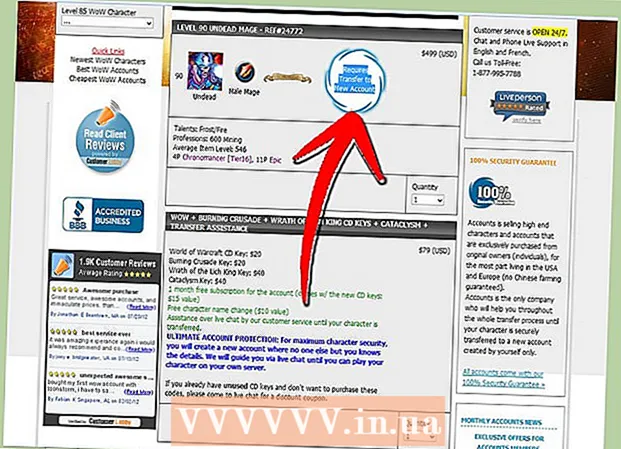Author:
William Ramirez
Date Of Creation:
18 September 2021
Update Date:
1 July 2024

Content
- Steps
- Part 1 of 3: Introductory part
- Part 2 of 3: Write the body of your letter
- Part 3 of 3: The final part
If you're writing a letter to someone you don't know personally, it's important in Spanish culture to keep it formal. Even if you speak Spanish, understand Spanish speech and Spanish texts, you may not yet know how to write an official letter. Most of the points in an official letter are the same regardless of the language in which the letter is written, but it is still recommended to follow certain cultural formalities when writing a letter in Spanish. These formalities vary depending on the status and age of the addressee, as well as on the reason for writing.
Steps
Part 1 of 3: Introductory part
 1 Enter the correct address to which you are sending the letter. If you are writing a formal letter, write your name and address in the upper right corner of the page, and the recipient's name and address on the left side of the page.
1 Enter the correct address to which you are sending the letter. If you are writing a formal letter, write your name and address in the upper right corner of the page, and the recipient's name and address on the left side of the page. - Most text editors include a specific formal letter template that will automatically format your letter.
- If you plan to print your letter on letterhead, you do not need to include your name and address.
- If you are writing an email, you do not need to include the address at the top of the page.
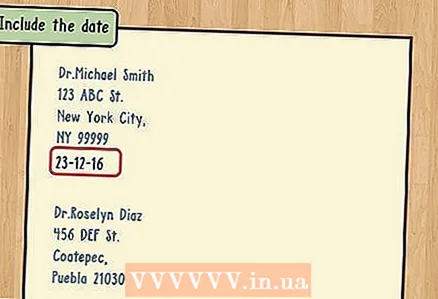 2 Enter the date. When sending a formal letter, at the top of the letter, indicate the date of writing. When you write an official letter in Spanish, the date may be preceded by the city you are writing from.
2 Enter the date. When sending a formal letter, at the top of the letter, indicate the date of writing. When you write an official letter in Spanish, the date may be preceded by the city you are writing from. - For example, you can write: "Acapulco, 28 de diciembre de 2018". In Spanish, a date is written as follows: first the date, then the month, and then the year. If you want to indicate the date only in numbers, write it like this: "28-12-18".
- If you are going to be typing on letterhead (or writing a letter to an acquaintance or friend in a more informal style), enter the date in the upper right corner (where you need to include your name and address).
- In official letters, the date is usually indicated on the left side of the letter under the name and address.
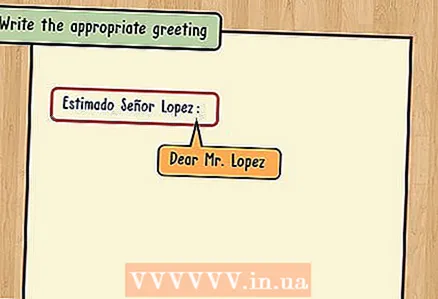 3 Write a greeting. The type of greeting depends on your relationship with the recipient and how well you know him. A casual greeting that works for a friend or good acquaintance may sound offensive to someone older than you (or someone you don't know personally).
3 Write a greeting. The type of greeting depends on your relationship with the recipient and how well you know him. A casual greeting that works for a friend or good acquaintance may sound offensive to someone older than you (or someone you don't know personally). - You can address the letter as follows: "A quien corresponponda" (or "to whom it may concern") if you do not know the name of the specific person who will read the letter. This greeting is suitable for formal and business emails, for example, when you are trying to gather additional information about a product or service.
- If the person you are texting is older than you (or if this is your first time texting), write "Estimada / o" and the person's last name. In a letter, you can address this person with the words "señor" or "señora". For example, you can write: "Estimado señor Lopez". This greeting literally translates to "Dear Mr. Lopez" (the same as "Dear Mr. Lopez" in Russian).
- When you have a close relationship with someone, you can use the greeting "Querido / a" followed by their name. For example, you could write “Querida Benita” (which means “Dear Benita”).
- In Spanish, after the greeting, it is customary to put a colon, and not a comma, as in Russian.
 4 Introduce yourself. In the first line of the letter, you must introduce yourself so that the person knows who is writing to him. Start your letter with "Mi nombre es" and include your full name. You can add your social status (indicating the position or marital status, if it is important in your letter).
4 Introduce yourself. In the first line of the letter, you must introduce yourself so that the person knows who is writing to him. Start your letter with "Mi nombre es" and include your full name. You can add your social status (indicating the position or marital status, if it is important in your letter). - For example, you can write: "Mi nombre es Sasha Sizova". Then indicate in one sentence who you are (a university student, relative, or acquaintance of the person).
- If you are writing on behalf of another person, you can add “Escribo de parte de” and then write that person's name. For example, you could write: "Escribo de parte de Margarita Florova".
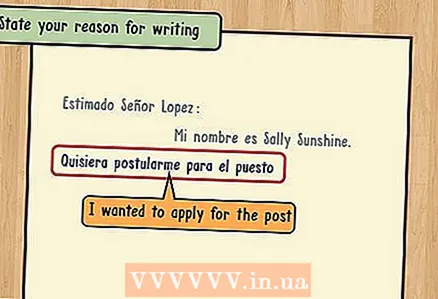 5 State the reason why you are writing. Immediately after you introduce yourself, you need to briefly write down the reason why you are writing to this person, what you need from him. You will describe this point in more detail in the main part of your letter, but in the greeting it is necessary to write briefly the essence of your appeal.
5 State the reason why you are writing. Immediately after you introduce yourself, you need to briefly write down the reason why you are writing to this person, what you need from him. You will describe this point in more detail in the main part of your letter, but in the greeting it is necessary to write briefly the essence of your appeal. - This will be something like a general summary of your letter. For example, if you are writing a letter to inquire about a job offer or internship, you could write “Quisiera postularme para el puesto” (that is, “I wanted to apply for this position”). Then you can tell where you saw the job description or internship (or how you found out about it).
- This part should be a maximum of two sentences and should include the first paragraph of the letter in which you introduce yourself.
Part 2 of 3: Write the body of your letter
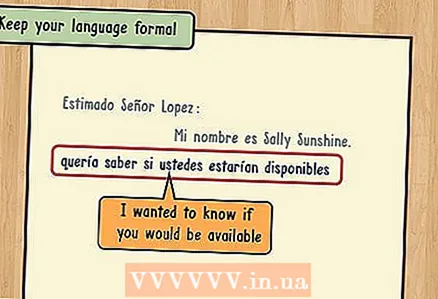 1 Stick to a formal style. Even if you are on relatively good terms with the person, it is customary in the culture of Spanish writing to adhere to a more formal style than in the culture of Russian.
1 Stick to a formal style. Even if you are on relatively good terms with the person, it is customary in the culture of Spanish writing to adhere to a more formal style than in the culture of Russian. - Compared to the Russian language, the Spaniards usually adhere to more neutral formulations in official letters. Therefore, the phrases will sound more conditional: “quería saber si ustedes estarían disponibles” or literally “I would like to know if you will be available”. If you are not in a close relationship with the person, use the formal address "usted" or "ustedes" (that is, "you").
- If you're unsure of how formal your letter should be, it's best to write in a more formal style. The likelihood of offending someone with an overly polite and formal style is much less than the likelihood of offending the other person by writing in a cheeky and casual tone.
- If you have met this person several times before (or you are responding to a letter this person wrote to you), think about the degree of formality of your conversation based on the past dialogue. Never allow yourself to address a person less formally than he is addressing you!
- Even if you are writing an email, slang expressions and abbreviations that we may use in Internet correspondence are not suitable for official writing in Spanish.
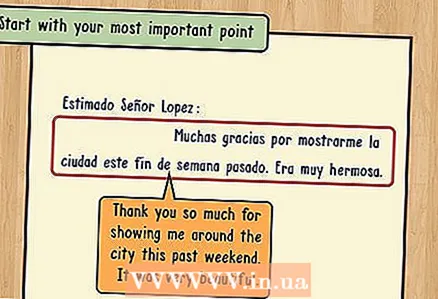 2 Start with the essentials. The main body of the letter should be structured so as to move from the most important to the least important. Try to write clearly and concisely so that the letter does not span more than one page.
2 Start with the essentials. The main body of the letter should be structured so as to move from the most important to the least important. Try to write clearly and concisely so that the letter does not span more than one page. - A personal letter (for example, a letter to a friend describing how you spent your vacation) can be of any length. But when it comes to a business or other formal letter, you need to respect the time of the person you are writing to. Do not leave the topic and do not write unnecessary information that does not relate to the main essence of the letter. You will make a good impression on the addressee with your ability to write official letters correctly.
- Perhaps, before writing a letter, it is worth briefly summarizing it in order to know exactly what points and proposals need to be made, how to arrange them. If you prepare to write in advance, it will be much easier, especially when it comes to writing in a foreign language.
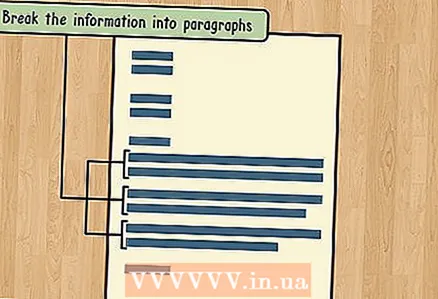 3 Break your letter into multiple paragraphs. Lines should be one-spaced, and paragraphs should be double-spaced. Do not fit more than two or three sentences in one paragraph.
3 Break your letter into multiple paragraphs. Lines should be one-spaced, and paragraphs should be double-spaced. Do not fit more than two or three sentences in one paragraph. - Each idea or new thought should be written with a new paragraph.
- For example, let's say you are writing a formal letter in Spanish about an internship. In this case, you will have two points that need to be voiced: your work experience, as well as the reason why your candidacy is best suited for this position. The letter should include a paragraph in which you introduce yourself, a paragraph in which you talk about your experience, a paragraph explaining why you are best suited for the job, and a final paragraph.
Part 3 of 3: The final part
 1 Summarize the purpose of the letter. Begin the final paragraph with a sentence or two describing the reason for your request. You can also include any closing remarks you have on the subject line.
1 Summarize the purpose of the letter. Begin the final paragraph with a sentence or two describing the reason for your request. You can also include any closing remarks you have on the subject line. - For example, if you are writing a letter to review your candidacy for an internship, you might include in the end a sentence that you have links to certain material that will be available upon request.
- If the letter consists of only a couple of paragraphs, this is not necessary. But it can be very useful for long letters (a couple of pages), because, first of all, it will bring the recipient back to the point on which you reached him.
- This final point is also optional if you are writing to a close friend or relative.
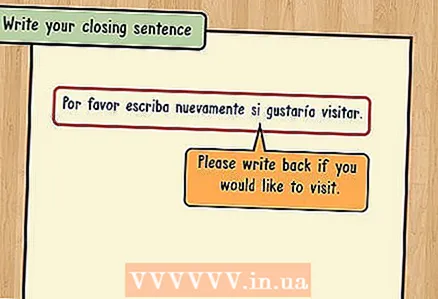 2 Write your final sentence. To finish the letter, tell the person you are writing to what result you expect. In the last sentence, you need to inform about what kind of decision you expect from this person (or about the time when you hope to receive his answer).
2 Write your final sentence. To finish the letter, tell the person you are writing to what result you expect. In the last sentence, you need to inform about what kind of decision you expect from this person (or about the time when you hope to receive his answer). - For example, if you are just waiting for an answer, and you do not have a specific waiting period, you can write: "Espero su respuesta" (which means: "I am waiting for your answer").
- If you think the person might have certain questions or want to talk to you, you can write: “Cualquier cosa estoy a su disposición” (which means “I'll be in touch if you have any questions”).
 3 Consider goodbye. In Russian, the letter is usually completed with the words "Goodbye" or "Sincerely yours", so a similar phrase in Spanish is also suitable for goodbye.
3 Consider goodbye. In Russian, the letter is usually completed with the words "Goodbye" or "Sincerely yours", so a similar phrase in Spanish is also suitable for goodbye. - The final phrase in Spanish is usually more formal than in Russian. The commonly used phrase is "Saludos cordiales", which literally translates to "Sincerely." If in a letter you ask a person for something, you can write: "Gracias y saludos", which literally means "Thank you and best wishes."
- If you do not know this person at all, if he is older than you or has a high social status, you can use the phrase "Le saludo atentamente". This final phrase is considered the most formal, and literally means "Sincerely." This is so formal that you practically imply that you might not be worthy of this person's greeting.
- If you are writing to a close friend or relative, you can use a more personal ending phrase, such as "Besos", which means "whole." This phrase may sound too intimate in Russian, but in Spanish writing this is the most common way to complete a letter.
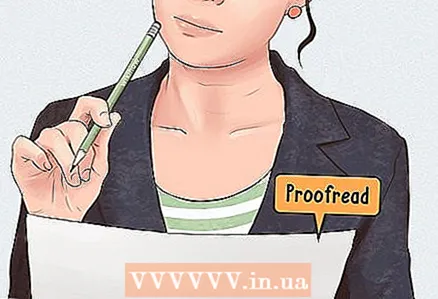 4 Check and edit the letter carefully. Especially if you wrote the letter using a text editor that is set to your native language by default, because you can make significant mistakes in punctuation and spelling. Careless writing will leave a bad impression of you and may be taken as a sign that you do not respect the person you are writing to.
4 Check and edit the letter carefully. Especially if you wrote the letter using a text editor that is set to your native language by default, because you can make significant mistakes in punctuation and spelling. Careless writing will leave a bad impression of you and may be taken as a sign that you do not respect the person you are writing to. - If automatic correction is turned on in your text editor, check the words carefully, especially if you have a different default language set up. Because the editor can change some words himself, and you, most likely, will not even notice it.
- Pay particular attention to punctuation. For example, Spanish questions start with a "" and end with a "?" This construction is unique to Spanish, and if you are not used to writing in Spanish, you might accidentally miss the first character.
 5 Enter your contact information. Even if you already have contact information at the top of the letter, it is usually customary to write your contact information at the end, under your name. This is especially important if you are writing a letter as a job applicant.
5 Enter your contact information. Even if you already have contact information at the top of the letter, it is usually customary to write your contact information at the end, under your name. This is especially important if you are writing a letter as a job applicant. - For example, if you are typing your letter on letterhead from an employer, it usually contains the company's contact information, but not your personal one.
- Include information about your preferred contact method. If you want the recipient of the letter to call you, please include the phone number after your name. If you would like to be contacted by email, please include your email address.
 6 Sign the letter. Once you are sure that the letter is written neatly and correctly, print it out and sign it. You need to skip a little space after the text and write the first and last name.
6 Sign the letter. Once you are sure that the letter is written neatly and correctly, print it out and sign it. You need to skip a little space after the text and write the first and last name. - Leave your signature after the first and last name.
- If it is a business letter, you can make a copy of the signed letter (to keep it with you) before mailing the letter.

